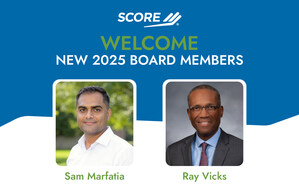Mentoring, Resources and Support Are Critical to Business Success
WASHINGTON, Oct. 25, 2022 /PRNewswire/ -- Formerly incarcerated individuals are 45% more likely to become entrepreneurs versus those without a criminal record but face greater challenges on the path to business success, according to a meta-analysis from SCORE, mentors to America's small businesses and a resource partner of the U.S. Small Business Administration.
The U.S. leads the world with the largest percent of its overall population in prison, with 2.2 million incarcerated individuals. For the 600,000 returning people released each year, finding employment can be difficult: the unemployment rate is 27.3% for the formerly incarcerated vs. 5.8% in the general population. Employment discrimination, limited resumes/skills, and legal restrictions limit the hiring of individuals with certain classes of convictions. Those who do find jobs earn lower wages, with median annual income at $10,000.
"Small businesses launched by the formerly incarcerated typically do not require much human or financial capital, such as cleaning services, construction, trucking or other service industry roles," said SCORE CEO Bridget Weston. "Most are funded with support from family and friends, or bootstrapping, which requires working multiple jobs to fund small business aspirations. In addition, formerly incarcerated entrepreneurs hire five people, on average, as their businesses grow."
Entrepreneurship offers a path forward for people rebuilding their lives after time in prison, resulting in higher income and lower recidivism. However, challenges remain:
- Probation and parole requirements limit the ability to spend time starting a business (as they are required to have a job)
- Financing is often denied due to a criminal record
- Lack of technology skills / education, particularly business classes
- Higher cost of doing business due to higher insurance premiums and limits on occupational licenses (as hours spent in prison vocational programs do not count)
Data shows that returning individuals who pursue entrepreneurship are 33% less likely to reoffend. In addition to reduced recidivism, formerly incarcerated entrepreneurs also achieved higher rates of both employment and income.
Successful entrepreneurship programs for the formerly incarcerated include key elements:
- Broad program activities and supports such as job readiness, financial management
- Mentoring
- Interdependence, networking and peer engagement
- Tailored credit building and credit access
In Connecticut, SCORE volunteers provided monthly business training at several prisons pre-pandemic. "We educated individuals six months before release to give them tools and a chance to be successful. They were eager to learn," explains Mark Cutler, regional vice president for SCORE Northeast. "Both pre- and post-release, SCORE's 10,000 expert mentors are uniquely equipped to provide our mentoring and educational services for free."
"Having someone believe in you makes a difference in whether you are successful as a returning citizen," said a formerly incarcerated SCORE client. "I knew what I wanted to do but not how. SCORE…provided information to help me on my journey."
Visit www.score.org to learn more.
Since 1964, SCORE has helped 11 million entrepreneurs start or grow a business. SCORE's 10,000 volunteers provide free mentoring, workshops and educational services to 1,500+ communities nationwide, creating 25,084 new businesses and 71,475 non-owner jobs in 2021 alone. Visit SCORE at www.score.org. Follow @SCOREMentors on Facebook, Twitter and LinkedIn.
Funded [in part] through a Cooperative Agreement with the U.S. Small Business Administration.
CONTACT:
SCORE
202-968-6428
[email protected]
https://www.sentencingproject.org/the-facts/#map
https://www.aspeninstitute.org/wp-content/uploads/2016/09/AFN-PrisonToProprietor.pdf
https://nycfuture.org/pdf/CUF_Reentry_Entrepreneurship_Report_6.pdf
SOURCE SCORE

WANT YOUR COMPANY'S NEWS FEATURED ON PRNEWSWIRE.COM?
Newsrooms &
Influencers
Digital Media
Outlets
Journalists
Opted In






Share this article